Packaged-food Labels
There is an art to reading packaged-food labels.
Front of the package
The front of the package is marketing. Some words sound healthier than they are. For example:
- Multi-grain most of the grains are likely refined grains — unless the product is marked as "whole grain".
- Made with whole grains the product may contain very little whole grains.
- Wheat flour is likely white flour.
- Enriched flour is white flour, where nutrients are removed and then some of the nutrients are added back in.
- All natural doesn’t contain added colors, artificial flavors, or “synthetic substances.” It can contain preservatives and highly processed foods like sugar, refined grains, oil.
- Vegan means it contains no animal products. It can contain any amount of processed foods e.g. Oreo cookies are vegan.
Never believe anything on the front of a package. Caveat emptor.
Ingredients list
Product ingredients are listed in descending order, with the greatest amount by weight listed first. Purchase products that have only whole foods listed as the first two ingredients. Avoid products with refined food in the ingredients list.
Sugar names:
- Sugars ending in "tose": fructose, lactose, galactose, maltose.
- Syrups: carob syrup, golden syrup, high-fructose corn syrup, honey, agave nectar, malt syrup, maple syrup, oat syrup, rice bran syrup, and rice syrup.
- Other added sugars: barley malt, malt powder, molasses, evaporated cane juice, corn sweetener, dextran, glucose, ethyl maltol, fruit juice concentrate, disaccharides, maltodextrin.
Oil names:
- oil, fat, lard
- Partially hydrogenated oil and hydrogenated oil contain trans fats.
- "Zero trans fat" on the nutritional label means "less than 0.5 grams of trans fat per serving." Thus, if the serving size is misleadingly small, the product may still contain significant amounts of trans fat.
Refined grains:
- white flour
- white rice
Protein isolates:
- soy protein isolate
- pea protein isolate
- seitan, gluten
When the ingredients list says, "Contains 2% Or Less Of The Following:"
The US Code of Federal Regulations (21 CFR 101.4) states that ingredients must be listed in descending order of predominance based on weight. The following exception is made in 21 CFR 101.4(2):
The descending order of predominance requirements of paragraph (a)(1) of this section do not apply to ingredients present in amounts of 2 percent or less by weight when a listing of these ingredients is placed at the end of the ingredient statement following an appropriate quantifying statement, e.g., "Contains _ percent or less of _ _ _" or "Less than _ percent of _ _ _." The blank percentage within the quantifying statement shall be filled in with a threshold level of 2 percent, or, if desired, 1.5 percent, 1.0 percent, or 0.5 percent, as appropriate. No ingredient to which the quantifying phrase applies may be present in an amount greater than the stated threshold.
For example,
Contains 2% Or Less Of The Following: Olive Oil, Corn Oil, Palm Oil.
The 2% applies to each item individually. So in the above example, up to 6% of weight could be oil.
They are also exempt from the order by weight requirement. The manufacturer is free to order the subset of less than 2% ingredients however they please. So the above example could contains more Palm Oil than Olive oil.
Nutrition Facts
fiber
If there it doesn't contain dietary fiber, it's not a whole food.
sodium
Check the serving size. If the serving size is misleadingly small, the product may contain much sodium.
Eliminating meat, cheese, and process foods usually brings salt intake down to healthy levels.
- The American Heart Association recommends no more than 2,300 milligrams (mg) sodium a day. That’s the amount in 1 teaspoon (5 ml) of table salt per day.
- The body needs only a small amount of sodium (less than 500 milligrams per day) to function properly. That’s the amount in less than ¼ teaspoon (1.2 ml) of table salt per day.
Cracker examples
Never believe anything on the front of a package.
Great Value Multi-Grain Crackers
From https://www.walmart.com/ip/Great-Value-Multi-Grain-Crackers-12-7-oz/724329705
Ingredients: Enriched Flour (Wheat Flour, Niacin, Reduced Iron, Thiamine Mononitrate, Riboflavin, Folic Acid), High Oleic Canola and/or Soybean Oil with TBHQ and Citric Acid for freshness, Sugar, Whole Wheat Flour, Defatted Wheat Germ, Contains 2% or less of: Salt, Oat Bran, High Fructose Corn Syrup, Leavening (Sodium Acid Pyrophosphate, Baking Soda, Monocalcium Phosphate), Degerminated Yellow Corn Flour, Corn Syrup, Corn Starch, Soy Lecithin, Sodium Sulfite
Observations from the Ingredients:
- technically a multi-grain because it contains 2 grains: "Wheat Flour" and "Whole Wheat Flour"
- front says "muli-grain" but is mostly refined grain and added oil
- the only whole ingredient is "Whole Wheat Flour"
- there is more added "Sugar" than "Whole Wheat Flour"
- "Oil" is the second ingredient
- this is highly processed food
Observations from the Nutritional Facts:
- Dietary Fiber is not listed
- 130mg sodium / 14g
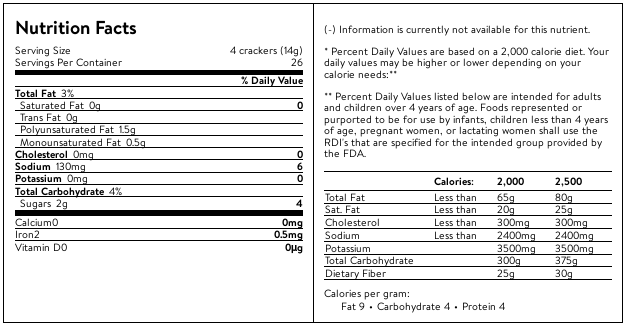
Mary's Gone Crackers Organic Original
From https://shop.sprouts.com/product/42995/mary-s-gone-crackers-organic-original-6-5-oz
Ingredients: Whole Grain Brown Rice, Whole Grain Quinoa, Brown Flax Seeds, Brown Sesame Seeds, Filtered Water, Sea Salt, Wheat Free Tamari (Water, Whole Organic Soybeans, Salt, Vinegar.). Organic
Observations from the Ingredients:
- The crackers are "multi-grain" and "100% whole grain" even though neither is mentioned on the front.
- These crackers are 100% whole food.
Observations from the Nutritional Facts:
- 190mg sodium / 30g = 89mg sodium / 14g
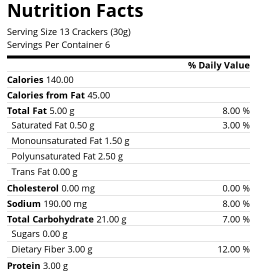
Wasa Light Rye Crispbread
From https://www.walmart.com/ip/Wasa-Light-Rye-Crispbread-9-5-oz-Pack-of-12/31219486
Ingredients: Whole Grain Rye Flour, Salt.
Observations from the Ingredients:
- These crackers are 100% whole food.
Observations from the Nutritional Facts:
- 70mg sodium / 18g
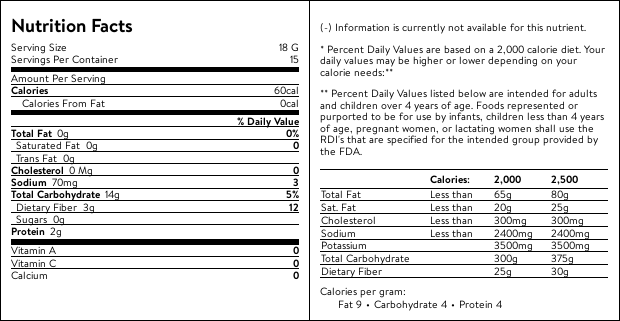
Hidden oil example
Most whole plant foods average around 10% fat by calories. That means if nutrition label says the food contains more than 10% of calories from fat, then it contains either a high-fat plant or more likely added oil. [reference: book "China Study Solution" page 164].
Hummus
From https://shop.sprouts.com/product/28254/sprouts-original-hummus-10-oz
Front of the jar says:
- ORIGINAL HUMMUS
Ingredients: Fresh Steamed Chickpeas, Sunflower Oil, Olive Oil, Sesame Tahini, Water, Sea Salt, Citric Acid, Roasted Garlic, Guar Gum, Cumin. Topping: Sesame Seeds.
Observations from the Ingredients:
- Oil is the second and third ingredient.
Observations from the Nutritional Facts:
- 66% of the calories are from fat.
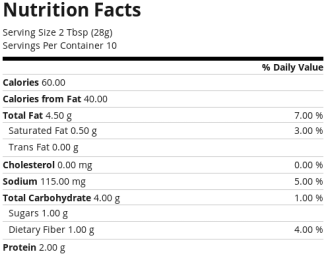
Chickpeas has 14% calories from fat.
https://fdc.nal.usda.gov/fdc-app.html#/food-details/339321/nutrients
9 Cal/g * 2.57g fat/163 Cal = 14% calories from fat
Sesame tahini has 77% calories from fat.
https://fdc.nal.usda.gov/fdc-app.html#/food-details/389490/nutrients
9 Cal/g * 60g fat/700 Cal = 77% calories from fat
Canned "fat free refried beans" is a low-fat alternative.
Spaghetti-sauce examples
Many WFPB doctors allow small amounts of added sugar to make food palatable to people accustomed to unnaturally sweat food. However, WFPB doctors insist on no oil because calorie density.
Muir Glen Tomato Basil Pasta Sauce
From https://shop.sprouts.com/product/31904/muir-glen-organic-tomato-basil-pasta-sauce-25-5-oz
Front of the jar says:
- MUIR GLEN TOMATO BASIL PASTA SAUCE
- ORGANIC
- NO SUGAR ADDED
Ingredients: Organic Tomato Puree (Water, Organic Tomato Paste), Organic Tomatoes In Juice, Organic Extra Virgin Olive Oil, Organic Sauteed Onion, Organic Carrot Puree, Organic Basil, Sea Salt, Organic Sauteed Garlic, Citric Acid, Calcium Chloride, Organic Fennel, Organic Black Pepper, Organic Oregano.
Observations from the Ingredients:
- oil is the third ingredient
- no added sugar
Observations from the Nutritional Facts:
- 50% of calories are from fat
- only 4.5g fat per 125g serving, yet half the calories are from fat (because food-energy density)
- contains saturated fat (because extra virgin olive oil is 14% saturated fat)
- more grams of fat than fiber
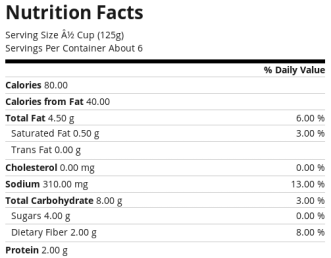
Hunts Pasta Sauce Traditional
Front of the can says:
- Hunts PASTA SAUCE Traditional
- Made from Vine Ripened Tomatoes
Ingredients: Tomato Puree (Water, Tomato Paste), Water, Less than 2% of: High Fructose Corn Syrup, Salt, Corn Syrup, Carrot Fiber, Sugar, Spices, Citric Acid, Spices, Natural Flavors.
Observations from the Ingredients:
- no added oil
- three kinds of added sugar
Observations from the Nutritional Facts:
- Includes 2g added sugars
- (4cal/g * 2g added sugar/serving) = 8 Calories per serving
- (4cal/g * 2g added sugar/serving) / (50cal/serving) = 16% calories is from added sugars
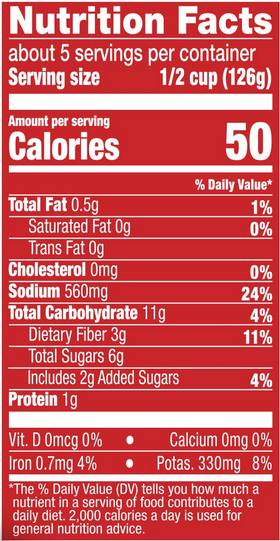
References:
http://www.plantplate.com/Guide/Detail?guideID=7039
https://www.nia.nih.gov/health/reading-food-labels
https://www.mamasezz.com/blogs/news/how-to-read-a-nutrition-label
https://vetnutrition.tufts.edu/2019/03/stop-reading-your-pet-food-ingredient-list/
- Ingredients lists are used as a powerful form of marketing
- Manufacturers include ingredients that will appeal to consumers but are often in such tiny quantities that I call them "fairy dust"
https://nutritionstudies.org/whole-food-plant-based-diet-guide/
- If purchasing a pre-packaged food product, be sure to carefully read the ingredients list.
- Product ingredients are listed in descending order, with the greatest amount by weight listed first.
- Purchase products with just a few recognizable plant-based ingredients.
- The less processed the better.
Avoid products with oils in the ingredient list.
https://plantbasednana.org/resources/resource-articles/324-reading-food-labels
Jeff Novick Rules and Guidelines:
- Never believe anything on the front of a package.
- Always read the nutrition facts label and the ingredients list.
- Check serving size.
- Check amount of servings per box.
- Check the calories per serving.
- Check the calories from fat.